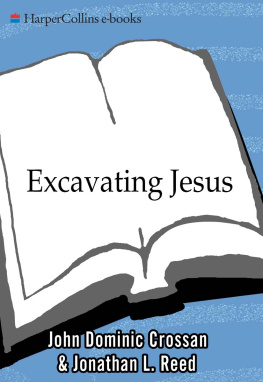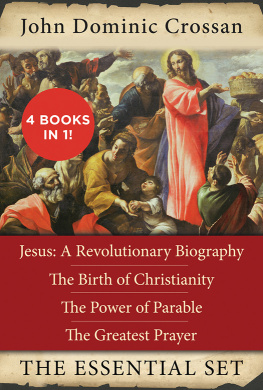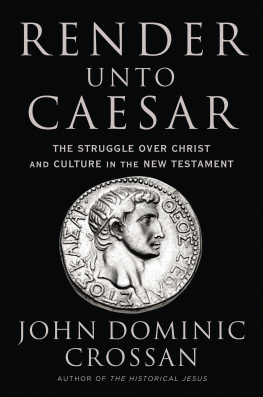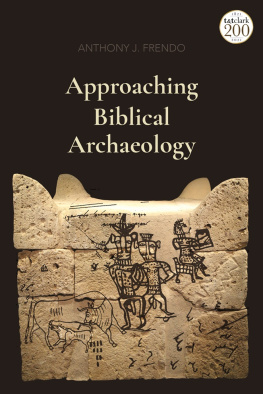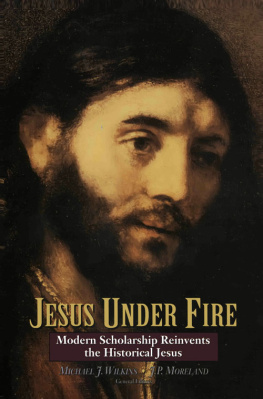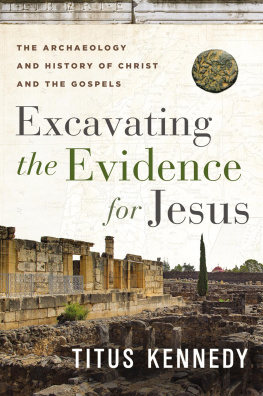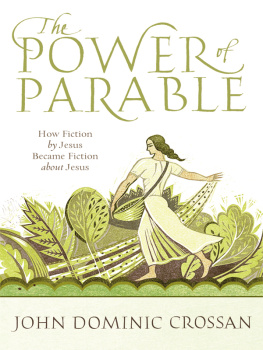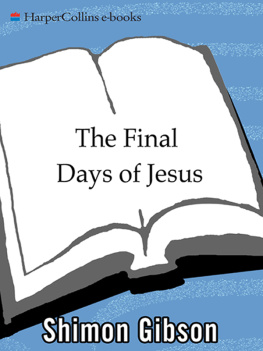John Dominic Crossan & Jonathan L. Reed
I t is Saturday afternoon, November 23, 2002. Torontos sky is gloomily clouded, its temperature in the upper 30s, but any wind off Lake Ontario is mercifully absent. The sidewalks outside the Royal Ontario Museum are crowded with people and, as our taxi stops, we worry about long lines to get in, getting our tickets, getting to see the exhibit. But we soon realize that those crowds are mostly young children, some with their parents but others with organized outings, and that they are there for a somewhat different experience. The museums McLaughlin Planetarium has a world exclusive on The Lord of the Rings: The Two Towers Exhibit , which contains artifacts from New Line Cinemas theatrical production of The Lord of the Rings. The children are there for artifacts of magical fantasy and, as we nudge through their line to enter the main building, we wonder if we adults are there for an artifact of biblical fantasy. And it is rather ironic to recall as we enter the museum that The Lord of the Rings is not a saga of quest but of antiquest, an attempt not to find what you do not have but rather to face what is thrust upon you.
The museums third level is dedicated to the Mediterranean World, extending from Mesopotamia and Egypt through Nubia and the Levant, and from Greece and Rome through Byzantium and Islam. Room 9 is reserved for Mediterranean World Features Exhibitions and there, in a few weeks of prodigious work, the museums staff had managed to mount a world premiere exhibit that would normally have taken a year to prepare. The rooms entrance and exit were shielded with semitransparent gauzelike screens, the walls were bright red with white lettering, and in the center, under Plexiglass, was a first-century Jewish bone box, or ossuary, with a small twenty-letter Aramaic inscription, James, son of Joseph, brother of Jesus. That inscription was enlarged graphically and dominated the back wall with an English translation above it and a French one below.
We were there for about two hours, watching the exhibit, watching ourselves respond, but also watching others react to what the media had called the most important archaeological discovery of Christianity. The room could hold about fifty to seventy-five people and there was a steady flow through it that whole afternoon. People moved in a clockwise circle reading the quotations and explanations on the walls before spiraling inward toward the ossuary itself. The exhibits designers chose, most appropriately, to emphasize texts over images and it worked brilliantly. Visitors read from the New Testament and from ancient authors such as Josephus, Hegesippus, and Eusebius. They read about Jewish reburial, Aramaic scripts, and Christian interpretations of Jesus as brother of James and son of Joseph. Some viewers may already have known all that information but, lurking and listening, it was impossible not to be deeply impressed by the Royal Ontario Museums most successful exercise in public education.
The first edition of this book established a dialectic of stone and text, an interaction of ground and gospel, an integration of archaeology and exegesis in which each discipline maintained its own full validity. Neither approach was reduced to footnote or background for the other. This revised edition changes nothing in that reciprocity. But the recently discovered ossuary, with possibly the oldest tangible evidence of Jesus, calls for a second edition using the discovery as a concentrated example, or focused symbol, for that process of integration. It is both a positive and a negative example.
After the discovery of the James ossuary and even before final conclusions are made on its authenticity, identity, and integrity, we knew we had to put it in our top ten list of archaeological discoveries for Excavating Jesus . But we were reluctant to lose a single one of the earlier ten so we made a virtue of necessity and combined two together. We could have combined Caiaphas and Pilate since they had cooperated for ten years and were both finally removed around the same time by their Roman superiors. But we decided on an alternative juxtaposition. The Romanization, urbanization, and commercialization of Lower Galilee focused on the Sea of Galilee in the 20s C.E . Pointedly, then, we combine both the Peter House and the Galilee Boat and call number five of our list the Sea of Tiberias (as it is called in John 6:1 and 21:1). Both the house and the boat reflect on the commercialization of lake fishing in different ways. That, we think, makes their combination significant. We decided to put the James ossuary in first place in our top ten list because of its importance in raising the profile of James and how he reflects on Jesus not only fraternally but theologically. And we put the James ossuary first because it underscores the importance of archaeology as a scholarly discipline and not as treasure hunting. We put it first because of the questions it raises.
There are five questions. Is the ossuary authentic? Is the inscription original? Is the family identifiable? Is the discovery important? Is the process ethical? We answer those last two immediately even if only provisionally. And these two answers will remain valid no matter what we, other scholars, or the press and public eventually decide on the first three questions.
The Discoverys Importance. The discovery is profoundly important simply because it gives a suddenly but properly high profile to James, son of Joseph, brother of Jesus. He was once well known as James the Just but has since become almost unknown in importance even if not in name. Maybe we should call him James the Lost. It is therefore about time to reconsider one who lived for over thirty years in early first-century Jerusalem accepted alike by both Christian Jews and non-Christian Jews, who disagreed with Paul and yet had Peter on his side, and whose death toppled the Jewish high priest Ananus II, who had him executed in 62 C.E. Second, when devout Jews, probably including Pharisees, protested that action, it was the Jewish ruler Agrippa II who dismissed Ananus II from office after only three months. The James ossuary reminds us how much of earliest Christian history involved Jewish groups in accord or discord with other Jewish groups, for example, Christian Jews in interaction with Pharisaic Jews and Sadducean Jews. Third, there was a time when James was far more important than Paul, and when James not Paul represented an ecumenical hope that ultimately failed but should be lamented none the less for that fact. Think counterfactually for a moment and mourn for what might have been. There was once a place where at least some Christian Jews and at least some Pharisaic Jews combined in opposing at least some Sadducean Jews. Once upon a time at least some might have been enough to change the future.
The Discoverys Ethics. The James ossuary has come to us through the sale of antiquities rather than excavation by archaeologists. We do not know, therefore, whether its original discovery was an unplanned finding or a planned looting, and the possibility of forgery will always haunt it. When such an artifact eventually surfaces to public awareness, individual scholars, learned societies, and museum authorities are caught in a double bind. To accept and discuss it may encourage paralegal searching, illegal looting, and unethical destruction of heritage. To avoid and ignore it may be impossible since even a refusal to discuss it is inevitably a comment upon it. We deliberately use the ossuary in this book to emphasize the difference between archaeological study and cultural looting.

